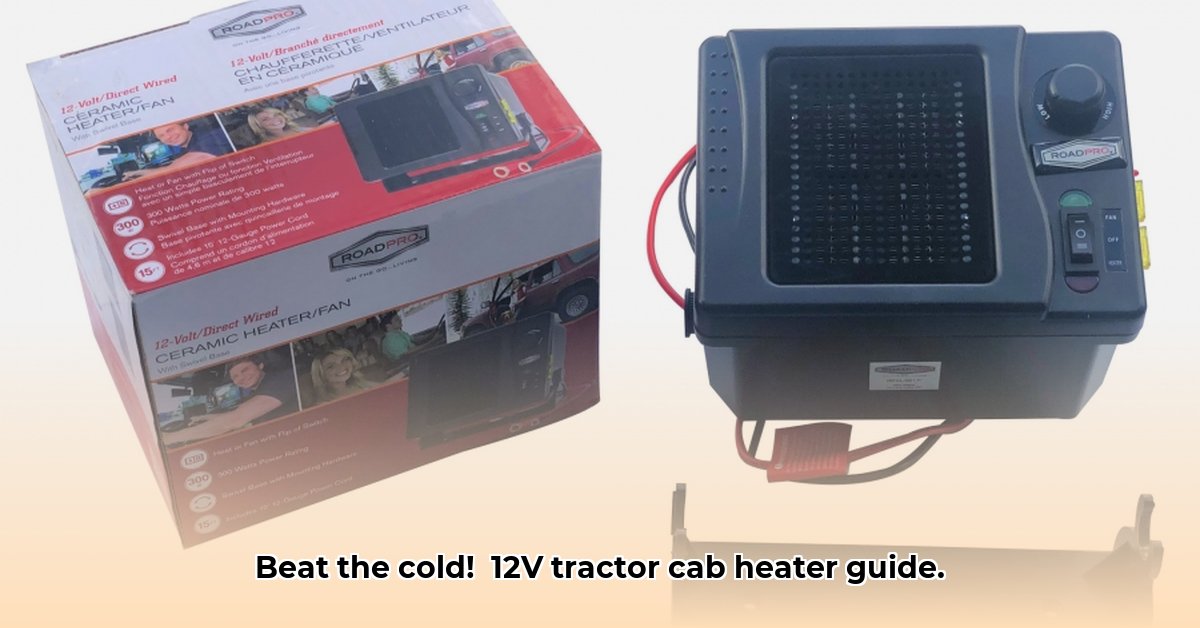
Freezing temperatures can make long hours in a tractor cab unbearable. A reliable 12V heater can significantly improve comfort and productivity. This guide helps you choose the right heater, install it safely, and troubleshoot common issues. We'll focus on practical information and real-world solutions to keep you warm all winter long. For more detailed information, check out this helpful resource.
Choosing the Right 12V Tractor Cab Heater
Selecting the best 12V heater involves understanding your needs and evaluating key features. While precise performance data is often lacking, focusing on these aspects will guide your decision:
Key Features to Consider
Wattage (Heat Output): Higher wattage means more heat but increased battery drain. Manufacturers usually provide wattage ranges (e.g., low, medium, high) rather than precise figures. Consider your cab size and desired warmth level. A smaller cab will likely need less wattage than a larger one. A larger wattage unit can quickly heat a cold cab, while a smaller unit may be adequate for less frigid days. A small cab might only need a low-wattage heater, while a larger cab may benefit from a higher wattage heater for quicker warm-up.
Fan Speed: Multiple fan speed settings offer control over airflow. A high-speed fan quickly warms the cab, while a lower speed maintains a comfortable temperature more consistently. Consider if this feature is vital to you. Multiple speeds provide significant flexibility and comfort adjustment.
Heat Settings: Multiple heat settings (e.g., low, medium, high) provide temperature flexibility to match varying conditions. The ability to fine-tune the temperature is a valuable feature, allowing you to adjust the warmth to your preference.
Size and Fit: Measure your cab before purchasing. Choose a heater that fits comfortably without obstructing your view or controls. Consider the placement – you need easy access to the controls without impeding vision or operation of the tractor.
Ease of Installation: Some heaters are easy to install; others may require professional help. Check user reviews for installation difficulty and required tools. A simple installation saves you time and potential headaches.
Safety Features: Prioritize heaters with safety features like thermostats (prevent overheating), safety shutoff switches, and fuse protection (safeguards against electrical surges). These features are paramount for safe operation.
Comparing 12V Tractor Cab Heaters
Direct comparisons are tough due to inconsistent manufacturer data. We'll group heaters based on features, creating a simplified comparison:
| Feature | Category A: Basic | Category B: Enhanced | Category C: Premium |
|---|---|---|---|
| Wattage | Low | Medium | High |
| Fan Speed | Single | Multiple | Multiple, Variable Output |
| Heat Settings | Low/High | Low/Med/High | Adjustable Thermostat, Multiple |
| Size/Dimensions | Compact | Medium | Larger |
| Installation | Relatively Easy | Some Technical Skill Needed | May Require Professional Install |
| Safety Features | Basic Fuse | Fuse, Safety Shutoff | Fuse, Thermostat, Multiple Switches |
Installing Your 12V Heater: A Step-by-Step Guide
Disclaimer: Always consult your tractor and heater manuals before installation. Improper installation is dangerous. Seek professional help if uncertain.
Preparation: Gather tools, review the wiring diagram, and choose a safe workspace. Ensure you have the necessary tools before starting and find a well-lit space to work.
Mounting: Securely attach the heater to a suitable location in your cab, ensuring adequate airflow and unobstructed operation. You want it safely positioned, away from obstructions or hazards.
Wiring: Connect the heater's (+) and (-) wires to your tractor's 12V power source using 12-gauge wire. Double-check polarity—incorrect connection is hazardous. Incorrect wiring can lead to failure or hazards.
Fuse Protection: Install the correct fuse in the fuse box to protect the heater and tractor's electrical system. This is a safety critical step.
Testing: With the ignition OFF, visually inspect all connections. With the ignition ON, test the heater for proper function and absence of strange sounds or smells. This is to ensure that everything is working as it should.
Final Check: Ensure all connections are secure, and the heater is firmly mounted. This is your last chance to review your installation before use.
Troubleshooting Common Problems
Heater Won't Turn On: Check the fuse and wiring connections.
Insufficient Heat: Check for airflow obstructions or increase the heat setting. You may need a higher wattage unit. Obstructions can affect the airflow, hindering heat output; consider a larger wattage unit if needed.
Strange Noises: Consult a professional mechanic for potential mechanical issues. Unusual noises may indicate a malfunction.
Safety Precautions: Prioritizing Your Well-being
Hot Surfaces: Avoid touching the heater during or immediately after operation.
Ventilation: Ensure adequate ventilation to prevent carbon monoxide buildup.
Regular Inspection: Periodically check wiring and connections for damage.
Malfunctions: Address any malfunctions promptly; do not continue operating a faulty heater.
Fuse Protection: Use the correct fuse and replace it if it blows.
Regulatory Considerations: Regional Variations
Sales taxes and regulations vary by location. Research local regulations before purchasing and installing. This is vital for compliance.
Conclusion: Stay Warm and Work Safely
Choosing and installing a 12V tractor cab heater requires careful consideration. By following this guide, you can improve your winter comfort while ensuring safe and efficient operation. Remember to prioritize safety and consult professionals when necessary.